Bab al-Tabbaneh–Jabal Mohsen conflict
| Bab al-Tabbaneh–Jabal Mohsen conflict | |||||
|---|---|---|---|---|---|
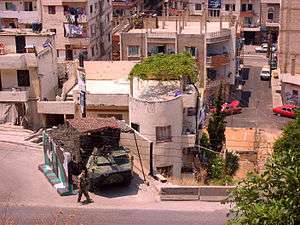 Lebanese army personnel on Syria Street, guarding the road between Bab al-Tabbaneh and Jabal Mohsen in 2011 | |||||
| |||||
| Belligerents | |||||
|
Salafists (during 2008 conflict) |
Arab Democratic Party (2012-present, from within Bab al-Tabbaneh) | ||||
| Commanders and leaders | |||||
|
Said Shaaban | Rifa'at Eid | ||||
| Strength | |||||
| ~1000 | ~400 | ||||
| Casualties and losses | |||||
| Hundreds | |||||
| ||||||
| ||||||
The Bab al-Tabbaneh–Jabal Mohsen conflict is a recurring conflict between Sunni Muslim residents of the Bab-al-Tibbaneh and Alawite Muslim residents of the Jabal Mohsen neighbourhoods of Tripoli, Lebanon. Residents of the two neighbourhoods have been rivals[2] since the Lebanese Civil War, and have often engaged in violence. They are divided along sectarian lines, as well as by their opposition or support of the Alawite-led Syrian government. Violence flared up during the Syrian Civil War spillover in Lebanon.
Background
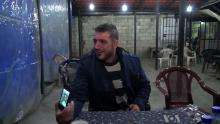
Sunni Muslims and Alawites have been in conflict with each other for centuries. The Alawites of the Levant were oppressed by the SunniOttoman Empire, but gained power and influence when the French recruited Alawites as soldiers during the French Mandate of Syria.[3][4][5][6] After independence from France, their co-religionists came to power in Syria in 1966 (represented by the al-Assad family since 1970).[7] This angered some of the Sunni majority of Syria, which reacted with an Islamist uprising in Syria, an insurgency which was crushed by the 1982 Hama massacre.[8]
With 500,000 inhabitants, Tripoli is the second largest city in Lebanon after Beirut. As an overwhelming part of these are Sunni Muslims, the city is considered the traditional bastion of conservative Sunnis in Lebanon.[9][10][11][12] In general, Sunnis represent 27% of the whole Lebanese population.[13][14] Being a Sunni stronghold, all major currents of Lebanese Sunni Islamism have been centered in the city.[15] Black banners with Quranic inscriptions crisscross the streets and dozens of free religious schools preach rigid Sunni doctrines and more women are spotted taking up the "niqab." Tripoli is also the birthplace of Lebanon's Salafi movement, a puritanical Sunni movement.[16][17] The Sunnis of Bab al-Tabbaneh and the rest of Lebanon have close ties with Saudi Arabia, which supports them financially.[18][19]
Nearly half of the Alawites of Lebanon are located in the Jabal Mohsen neighbourhood of Tripoli and nearby villages in Akkar, north Lebanon. 40-60,000 Alawites live in Tripoli,[20] and their entire population in Lebanon is 120,000 at most.[21][22][23][24][25] They have close ties with the Alawites in Syria, including the ruling Assad family.[26]
The two neighbourhoods are divided by Syria Street, Jabal Mohsen stands on a hilltop, Bab al-Tabbaneh stands below it.[27] Many residents in the two neighbourhoods are unemployed, which makes them easy to mobilize when clashes erupt.[28] North Lebanon is one of the most impoverished parts of Lebanon and is neglected by the government, leaving room for extremism to grow.[29] The neighbourhoods were prosperous until a flood in the 1960s destroyed many buildings, which was followed by the civil war. There are still many architectural treasures in the area.[30]
During the Lebanese Civil War

During the Lebanese Civil War that lasted from 1975 to 1990, Lebanese Alawites in the Jabal-Mohsen-based Arab Democratic Party (ADP) aligned with Syria, fought alongside Syrian Army against the Sunni Islamist Tawhid Movement in Tripoli, which was based mainly in Bab-Tabbaneh.[31] Before the war, the populations of the two neighbourhoods were interwoven.[32]
In August 1984, violent clashes erupted between the Tawheed and the ADP, with the former been supported by the Mosques Committee and the Islamic Committee. The Tawheed’s position was strengthened when they gained control of the port area on 22 August, after a fierce battle on the streets of Tripoli that left more than 400 dead. Street fighting dragged on for some days until 18 September, when it was brought to an end by a Syrian-mediated peace agreement between the IUM and the ADP.[33] By 1985, Tawhid had control over Tripoli, and the ADP was entrenched in Jabal Mohsen.[34]
On 18 December 1986, the Tawheed commander Samir al-Hassan was arrested by the Syrians in Tripoli. His men responded by killing 15 Syrian soldiers at a checkpoint, which brought the wrath of the Syrians on the Tawheed. Aided by ADP, LCP, SSNP and Baath Party militias, the Syrians managed to defeat decisively the Tawheed, killing many of its fighters, arresting others and scattered the remainder.[35]
2008 conflict
During the 2008 conflict in Lebanon, pro-government Sunnis fought against anti-government Alawites.[36] The ADP rearmed during the 2007 Lebanon conflict, after it was revealed that the Islamist group Fatah al-Islam had planned to attack the Alawites of Tripoli.[20]
During the night between 10 May and 11 May, heavy fighting broke out between Alawite Hezbollah sympathizers and Sunni supporters of the government in Tripoli. One woman was killed.[37]
On 11 May, Sunni supporters of the government had reportedly been fighting opposition followers in the Alawite dominated Jabal Mohsen area with machine-guns and rocket-propelled grenades.[38] On 12 May clashes in Tripoli left one person dead and at least six others wounded.[39] The Army stated that if the clashes did not end by morning of the next day they will intervene and use force if necessary to end the fighting.
On 22 June and 23 June, at least nine people, eight civilians and a policeman, were killed and 55 others were wounded in Tripoli, in clashes between pro-government Sunnis based in the Bab el-Tabaneh district and pro-Syrian Alawites from Jabal Mohsen. Machine guns and rocket-propelled grenades were used in the clashes, which started around four in the morning.[40]
Between 25 and 29 July, 23 September people were killed in clashes between Sunni and Alawite militants in Tripoli. On 8 September, Alawite and Sunni leaders signed a reconciliation agreement, which ended the fighting and tension which has haunted Tripoli since the civil war.[41][42] Sunni Future Movement leader Saad Hariri subsequently visited Tripoli stating "We are both Lebanese and we will not allow anyone to tamper with us. I will do everything I can in order not to let anyone damage the Alawites' security in Tripoli and to foil any external plot to tamper with the security of the Alawites or the security of Tripoli".[43]
Rifa'at Eid, current leader of the armed wing of the ADP said in an interview: "We're the most convenient targets, the stand-in for Hezbollah, our problem can only be solved when the Shiites and Sunnis solve theirs."[44] As many as 9,000 Alawis fled their homes during the conflict.[45]
2009
In October 2009, Jabal Mohsen was attacked with grenades by unknown assailants.[46]
2010
In spite of "missiles" having been launched into Jabal Mohsen a few months before, children from both neighbourhoods, along with children from adjacent villages and refugee camps, played peaceful football-matches in mixed teams during the Open Fun Football Festival on 2 November 2010.[47]
Weeks later, rockets were again fired into Jabal Mohsen, and a bomb was found near the house of ADP leader Ali Eid.[48][49]
Clashes during the Syrian Civil War
June 2011 clashes
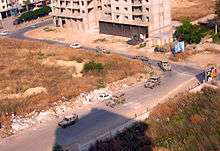
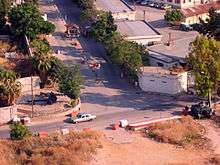
Seven people were killed and 59 were wounded in Tripoli, on Friday, 17 June 2011. Armed clashes erupted following a rally in support of Syrian protesters in Bab-al-Tabbaneh. Fighting broke out between gunmen positioned in Jabal Mohsen and Bab al-Tabbaneh. Among the dead were a Lebanese army soldier and an official from the Alawite ADP.[50]
February 2012 clashes
Between 10–11 February 2012, two[51] to three people died in fighting in the northern Lebanese city of Tripoli, in the neighbourhoods of Jabal Mohsen and Bab al-Tebbaneh. The Lebanese Army stepped in and suffered six injured soldiers.[52][53] There was a fear that the Syrian Civil War would spill into Lebanon.[54]
May 2012 clashes
Between two to four people were killed when fighting erupted on the night of 12–13 May in the Lebanese city of Tripoli between members of the Alawite minority, loyal to Syrian president Bashar al-Assad, and members of the Sunni majority, witnesses and security officials said.[51][55][56] Rocket-propelled grenades and automatic rifles were used in the fighting in an Alawite enclave and surrounding Sunni neighborhoods in the port city.[55]
Hours before the clashes, Lebanese troops exchanged fire late Saturday, 12 May, with a group of young Islamists, protesting in Tripoli for the release of a terrorist suspect.[55] The outbreak of gunfire between the Islamists and the army happened as the youths, sympathizers with the ongoing revolt in Syria, tried to approach the offices of the pro-Assad Syrian Social Nationalist Party in Lebanon.[55]
In all, three of the dead were reportedly Sunni civilians, while one was an army officer.[56]
The fighting continued on 14 May, with six more people being killed, five Alawites and one Sunni.[57][58]
The army deployed to the area on 15 May, and engaged in gunbattles with residents that left eight wounded, including a soldier.[59] By 16 May, the clashes had left 11 dead.[60]
"Western diplomatic sources" stated these incidents were the beginning of a Salafist revolution, aimed at arming the uprising in Syria.[61] The Saudi-backed March 14 coalition accused Syria of trying to drag Lebanon into its crisis. "It is actually an attempt to make of Tripoli a zone of terrorism. It also aims at striking Lebanon's northern area which has welcomed and helped out the Syrian displaced," said 14 March figure Mustafa Alloush after the coalition held its regular weekly meeting. Tripoli and north Lebanon have seen an influx of Syrian refugees since the unrest in Syria began in March 2011.[60]
By 18 May, a total of 12 people were dead and over 100 wounded in the May clashes.[62]
On 21 May, several RPGs where fired between the two neighbourhoods, with no reports of wounded.[63] On 30 May, two more were wounded in clashes between the neighborhoods.[64]
One Sunni-Muslim fought alongside the ADP and was killed in the May clashes, and was condemned as a traitor by his fellow Sunnis.[65]
June 2012 clashes
On 2–3 June, 15 people were killed and over 60 wounded in clashes between the neighborhoods. As a result of the fighting, the Army re-entered Syria Street, which divides the warring neighborhoods, to set up a buffer zone between the two sides.[66][67][68][69] Following the declaration of a cease-fire, there were several violations of the truce during the night of 3 June, in which one policeman and one soldier were wounded.[70] On 8 June, a man in Jabal Mohsen was killed by sniper fire.[71]
During the fighting, Jabal Mohsen was attacked from several fronts that encircle it, the Bab al-Tabbaneh, Shaarani, Baqqar, Riva, Mankoubin and Malouleh districts. In the aftermath, several Alawite businesses in Tripoli were burnt down.[72]
July 2012 clashes
On 18 July, one was killed and several were wounded by stray bullets fired during anti-Assad celebrations in Bab Tabbaneh, following a suicide-bombing targeted against several Syrian ministers.[73][74]
On 21 July, Tabbaneh residents clashed over non-political matters between two Sunni families, killing two and wounding several.[75][76] Two more were killed in the dispute on 29 July.[77]
On 27 July, two men who were on their way home to Jabal Mohsen were stabbed by unidentified assailants, which led to clashes between gunmen.[78] Clashes continued the following day, wounding 12, and three soldiers.[79][80]
August 2012 clashes
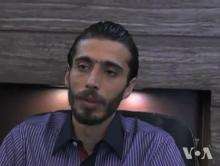
On 9 August, Sunni supporters of Hezbollah clashed with Salafists in Tripoli.[81]
On 20 and 21 August, seven people were killed and more than 100 wounded in clashes between Sunni Muslims and Alawites in Lebanon's northern city of Tripoli in another spillover from the war in neighboring Syria, according to security and medical sources. Two of the dead were from Jabal Mohsen, while the rest were from Bab al-Tabbaneh. Five Lebanese soldiers were injured by gunfire on 20 August, and another five on the next day after a grenade was lobbed at an army checkpoint.[82][83]
Fighting continued throughout 23 August, with at least 2 further deaths reported.[84]
On 24 August, further fighting occurred after a dawn exchange of small arms fire and rocket-propelled grenades between Sunni and Alawite fighters in the Qobbah and Jabal Muhsin neighborhoods. The skirmish provoked unrest throughout both districts, and at least 7 Alawite-owned shops in Sunni neighborhoods were torched by unknown assailants. Fighting escalated after the death of Sunni cleric Sheikh Khaled al Baradei, shot by a sniper during the morning skirmishes. Sheikh Baradei was reportedly a commander of the Sunni Islamist fighters, and his death led to further sectarian unrest within the city. Two journalists from an unknown news agency were also wounded during the day's fighting. At least 3 killed and 21 wounded were reported.[85] Fighting continued until 24 August.
October 2012 clashes
Clashes broke out on 19 October following the killing of Wissam al-Hassan, leaving one dead.[86] On 21 October, violent clashes occurred throughout the country which were triggered by the assassination. Two young girls and a man were killed during clashes between Bab Tabbaneh and Jabal Mohsen.[87] The parents of one of the girls, a nine-year-old called Jana, crossed sectarianlines, as her father is Sunni and her mother is Alawite.[88] Two Sunnis and one Alawi were killed on 22 October.[89]
By 24, 11 October people had been killed in the fighting.[90]
December 2012 clashes
At least 12 people were killed and 73 injured in Tripoli between 4 and 6 December, as Alawites and Sunnis were involved in heavy clashes, which were sparked by the Tall Kalakh incident, where 20 Lebanese Salafists that were going to join the insurgent in Syria were ambushed.[91][92][93][94][95][96]
2013 clashes
On 28 February, five men were arrested for throwing grenades into both neighbourhoods. They claimed they had been tasked by "Z.S." to create strife.[97] During March 2013, several sporadic incidents happened between the neighbourhoods. Two were hurt by sniper fire in Jabal Mohsen.[98] Three days later, a man from Jabal Mohsen was shot and killed.[99]
By 22 March, six people, including an army soldier, had been killed. On 23 March, three more people were killed.[100]
On 19 and 20 May, two civilians and two army soldiers were killed during renewed fighting between the neighbourhoods.[101] By 22, 12 May people had been killed since renewed fighting began.[102] The Lebanese army pulled out of the city on 23 May, after being targeted.[103] Six more were killed the following night, as mortars were used for the first time.[104] 31 were killed by 26 May.[105] After two days of calm, six more were killed by 4 June within 24 hours. Jabal Mohsen was subsequently raided by the army, which ADP leader Rifa'at Eid questioned, since similar raids were not done against Bab al-Tabbaneh.[106]
On 29 and 30 November, 13 people were killed by clashes.
August 2013 Tripoli bombing
On 23 August 2013, twin bombings in Tripoli caused extensive damage with some 47 people killed and more than 500 wounded according to Lebanon's state-run National News Agency.[107]
Abdul Rahman Diab assassination
On 20 January 2014, Abdul Rahman Diab, an ADP official, was gunned down in his car in Tripoli.[108]
March 2014 clashes
During nine days of March 2014, 25 people were killed and 175 were wounded.[109]
January 2015 Jabal Mohsen suicide attacks
On 10 January 2015, nine people were killed and more than 30 wounded in a Jabal Mohsen café when two suicide bombers from the area of Tripoli blew themselves up. It was the first suicide attack on a civilian neighbourhood in nearly a year, following a security sweep.[110]
References
- ↑ "Syrian violence finds its echo in Lebanon". Mcclatchydc.com. Retrieved 22 October 2014.
- ↑ "Truce declared in Tripoli between Bab al-Tabbaneh, Jabal Mohsen". Ya Libnan. 11 February 2012. Retrieved 27 November 2012.
- ↑ Mordechai Nisan. Minorities in the Middle East: a history of struggle and self-expression. McFarland, 2002. ISBN 0-7864-1375-1, ISBN 978-0-7864-1375-1
- ↑ Inside the Arab World. Books.google.dk. Retrieved 22 October 2014.
- ↑ "Making Sense of the Syrian Crisis". Stratfor. Retrieved 22 October 2014.
- ↑ Seale, Patrick. Asad Of Syria : The Struggle For The Middle East / Patrick Seale With The Assistance Of Maureen McConville. Seale, Patrick. Berkeley : University of California Press, 1989, c1988.
- ↑ Kaplan, Robert (February 1993). "Syria: Identity Crisis". TheAtlantic.com.
But the coup of 1970, which brought an Alawi air force officer, Hafez al-Assad, to power, was what finally ended the instability that had reigned in Syria since the advent of independence.
- ↑ Shadid, Anthony (26 April 2011). "International Outcry Grows Over Syria Crackdown". The New York Times. Retrieved 3 May 2011.
- ↑ "Sunni camp splits". Asiaonet. Retrieved 2010-01-28.
- ↑ "Tripoli cell burst". Presstv. Retrieved 2010-08-13.
- ↑ "Sunni capital". Naharnet. Retrieved 2010-07-04.
- ↑ Zoi Constantine (2010-05-25). "Pressures in Syria affect Alawites in Lebanon - The National". Thenational.ae. Retrieved 2011-11-14.
- ↑ "Lebanon". U.S. Department of State. Retrieved 22 October 2014.
- ↑ 23 Dec 2008 (2008-12-23). "Asia Times Online :: Middle East News, Iraq, Iran current affairs". Atimes.com. Retrieved 2011-11-14.
- ↑ "ISLAMIST GROUPS IN LEBANON". Mafhoum.com. Retrieved 22 October 2014.
- ↑ "Äóîé Áářčçúé". .alwatan.com.kw. Retrieved 2011-11-14.
- ↑ "» Kuwait Times Website". Kuwaittimes.net. Retrieved 2011-11-14.
- ↑ Lucy Fielder. "Al-Ahram Weekly - Region - Trial by fire for Lebanon's government". Weekly.ahram.org.eg. Retrieved 22 October 2014.
- ↑ "Tripoli". Hugh Macleod. Retrieved 2010-07-04.
- 1 2
- ↑ "Lebanon's Alawites Watch and Wait as Assad Struggles for Power". Naharnet. Retrieved 22 October 2014.
- ↑ "‘Lebanese Allawites welcome Syria’s withdrawal as ‘necessary’ 2005" (PDF). The Daily Star. 30 April 2014.
The Alawis have been present in modern-day Lebanon since the 16th century and are estimated to number 100,000 today, mostly in Akkar and Tripoli
- ↑ "Lebanon’s Alawi: A Minority Struggles in a ‘Nation’ of Sects". Al Akhbar English. Retrieved 22 October 2014.
- ↑ United Nations High Commissioner for Refugees. "Refworld - Lebanon: Displaced Allawis find little relief in impoverished north". Refworld. Retrieved 22 October 2014.
- ↑ United Nations High Commissioner for Refugees. "Refworld - Lebanon: Displaced families struggle on both sides of sectarian divide". Refworld. Retrieved 22 October 2014.
- ↑ "Syria Street divides them". Nowlebanon.com. 13 February 2012. Retrieved 22 October 2014.
- ↑ Fisk, Robert (2012-02-13). "Homs bloodshed spills over into Lebanon". The Independent (London).
- ↑ "Tripoli Clashes: Keeping Conflict Alive". English.al-akhbar.com. Retrieved 22 October 2014.
- ↑ "Tripoli, North Lebanon: The Forgotten City". Al Akhbar English. Retrieved 22 October 2014.
- ↑ "The Illustrious Past of Tripoli’s "Frontline"". Al Akhbar English. Retrieved 22 October 2014.
- ↑ "LEBANON’S POLITICS: THE SUNNI COMMUNITY AND HARIRI’S FUTURE CURRENT". Crisisgroup.org. Retrieved 22 October 2014.
- ↑ "New Crisis, Old Demons in Lebanon: The Forgotten Lessons of Bab-Tebbaneh/Jabal Mohsen - International Crisis Group". Crisisgroup.org. 2010-10-14. Retrieved 2012-10-23.
- ↑ O'Ballance, Civil War in Lebanon (1998), pp. 146-7.
- ↑ "The Glasgow Herald - Google News Archive Search". News.goog.le.com. Retrieved 22 October 2014.
- ↑ O'Ballance, Civil War in Lebanon (1998), p. 171.
- ↑ "North Lebanon reconciliation struck through joint efforts". News.xinhuanet.com. 2008-09-09. Retrieved 2011-11-14.
- ↑ "Lebanese army sends troops north". BBC. 2008-05-11. Retrieved 2008-05-16.
- ↑ "Day 5: Lebanese dare to hope worst is over". The Daily Star (Lebanon). Retrieved 2008-05-12.
- ↑ "Lebanon army gives gunmen deadline to disarm". Al Arabiya. Archived from the original on 2008-05-17. Retrieved 2008-05-13.
- ↑ Bassem Mroue. "Fighting breaks out in northern Lebanon; 4 dead". Associated Press. Retrieved 2008-09-10.
- ↑ "Nine killed in sectarian fighting in Lebanon". France 24. Archived from the original on 20 May 2011. Retrieved 2008-09-10.
- ↑ Suzan Haidamous. "North Lebanon reconciliation struck through joint efforts". Xinhua News Agency. Retrieved 2008-12-24.
- ↑ "Hariri tells Alawites in north Lebanon: We are all Lebanese". Ya Libnan. Retrieved 2008-12-24.
- ↑ "Tripoli Turmoil Increases Risk of a Sunni-Shiite War in Lebanon". Bloomberg. 2008-09-29.
- ↑ "Robert Fisk: Al-Qa'ida sends its warriors from Iraq to wage 'jihad' in Lebanon". The Independent (London). 2008-08-15.
- ↑ "Jabal Mohsen and Bab al-Tabbaneh targeted by three Energa grenades after first day of violence". Nowlebanon.com. 8 October 2009. Retrieved 22 October 2014.
- ↑ "IRIN Middle East - LEBANON: Football unites for a day - Lebanon - Governance - Security". Irinnews.org. Retrieved 22 October 2014.
- ↑ "Two grenades fired into Tripoli's Jabal Mohsen district". The Daily Star Newspaper - Lebanon. Retrieved 22 October 2014.
- ↑ "Energa round falls in Jabal Mohsen". Nowlebanon.com. 28 November 2010. Retrieved 22 October 2014.
- ↑ "Lebanon... Perils of the Syrian Quake Aftershocks" (PDF). Studies.aljazeera.net. Retrieved 22 October 2014.
- 1 2 "Several dead in clashes in Lebanon's Tripoli". Aljazeera.com. Retrieved 22 October 2014.
- ↑ Wood, Josh (2012-02-15). "Syria's Unrest Felt by Military in Lebanon". The New York Times.
- ↑ "Syrian violence spills over into Lebanon". Aljazeera.com. Retrieved 22 October 2014.
- ↑ "Calm returns after 3 die in north Lebanon violence". The Daily Star Newspaper - Lebanon. Retrieved 22 October 2014.
- 1 2 3 4 "At least two killed as Alawite-Sunni fighting erupts in Lebanese port city". English.alarabiya.net. Retrieved 22 October 2014.
- 1 2 "North Lebanon clashes claim 3, army restores order". The Daily Star Newspaper - Lebanon. Retrieved 22 October 2014.
- ↑ "6 Dead, 70 Hurt as Clashes Spread in Tripoli and Islamists Reclose al-Nour Square". Naharnet. Retrieved 22 October 2014.
- ↑ "North Lebanon clashes escalate, kill 5". The Daily Star Newspaper - Lebanon. Retrieved 22 October 2014.
- ↑ "Lebanese soldier among 8 wounded in north Lebanon clashes". The Daily Star Newspaper - Lebanon. Retrieved 22 October 2014.
- 1 2 "Clashes Resume in Tripoli : Several Wounded". English.al-akhbar.com. Retrieved 22 October 2014.
- ↑ "Diplomats Say 'Salafist Revolution' in Tripoli Aim at Arming Syrian Opposition". Naharnet. Retrieved 22 October 2014.
- ↑ Geagea: Hezbollah training, arming Tripoli groups
- ↑ "4 Inerga rocket-propelled grenades fired in north Lebanon: residents". The Daily Star Newspaper - Lebanon. Retrieved 22 October 2014.
- ↑ "Dispute between rival Tripoli residents wounds 2". The Daily Star Newspaper - Lebanon. Retrieved 22 October 2014.
- ↑ "Hezbollah role clouds Tripoli battleground". The Daily Star Newspaper - Lebanon. Retrieved 22 October 2014.
- ↑ "Tense calm returns to Lebanon's Tripoli". Al Akhbar English. Retrieved 22 October 2014.
- ↑ "Cautious calm in north Lebanon marred by sporadic shooting". The Daily Star Newspaper - Lebanon. Retrieved 22 October 2014.
- ↑ Lebanese army deployed in Tripoli after 15 killed
- ↑ "Many killed as Lebanese clash over Syria". Aljazeera.com. Retrieved 22 October 2014.
- ↑ "Several ceasefire violations were reported in Tripoli". Ya Libnan. 3 June 2012. Retrieved 27 November 2012.
- ↑ "One killed, one wounded by sniper fire in north Lebanon". The Daily Star Newspaper - Lebanon. Retrieved 22 October 2014.
- ↑ "The view from Tripoli’s restive Jabal Mohsen". The Daily Star Newspaper - Lebanon. Retrieved 22 October 2014.
- ↑ "One Killed in Tripoli by Gunshots Fired in Celebration of Damascus Bombing". Naharnet. Retrieved 22 October 2014.
- ↑ "One dead in Lebanon after anti-Assad celebrations". Al Akhbar English. Retrieved 22 October 2014.
- ↑ "Two killed, 7 wounded in north Lebanon family dispute". The Daily Star Newspaper - Lebanon. Retrieved 22 October 2014.
- ↑ "One Killed as Personal Dispute Escalates into Armed Clash in Bab al-Tabbaneh". Naharnet. Retrieved 22 October 2014.
- ↑ "2 Dead, 5 Hurt as Families Dispute Erupts into Gunfire in Bab al-Tabbaneh". Naharnet. Retrieved 22 October 2014.
- ↑ "Fighting Erupts in Rival Tripoli Districts, Army Hits Back at Shooters". Naharnet. Retrieved 22 October 2014.
- ↑ "Tripoli Clashes Leave 12 Wounded". Naharnet. Retrieved 22 October 2014.
- ↑ "Three Lebanese soldiers wounded in fresh Tripoli clashes". Al Akhbar English. Retrieved 22 October 2014.
- ↑ "Hezbollah ally camps out in mosque after Tripoli clashes". The Daily Star Newspaper - Lebanon. Retrieved 22 October 2014.
- ↑ "Fighting in Lebanese city for second night, 7 killed". Reuters. 21 August 2012.
- ↑ Thomson Reuters Foundation. "Fighting in Lebanese city for second night, 7 killed (Reuters)". Trust.org. Retrieved 22 October 2014.
- ↑ "Lebanon clashes: Fresh clashes breach truce in Tripoli". BBC News. BBC. 23 August 2012. Retrieved 23 August 2012.
- ↑ "Sunni cleric killed in north Lebanon clashes". BBC News. 24 August 2012. Retrieved 24 August 2012.
- ↑ "Syria blamed for deadly Lebanon blast - Middle East". Al Jazeera English. 20 October 2010. Retrieved 2012-10-23.
- ↑ "Three dead in Tripoli clashes, arrests made". The Daily Star. 2012-08-27. Retrieved 2012-10-23.
- ↑ "The innocent lives lost in Tripoli’s battles". The Daily Star. 26 October 2012. Retrieved 27 November 2012.
- ↑ Holmes, Oliver (23 October 2012). "Fighting flares in Lebanese city over Syria loyalties". Reuters. Retrieved 2012-10-23.
- ↑ "Ceasefire Declared, Army Deploys in Tripoli after 11 Killed, 39 Hurt". Naharnet. 2012-10-23. Retrieved 2012-11-27.
- ↑ "Fatal sectarian clashes in Lebanon’s Tripoli". Aljazeera.com. Retrieved 22 October 2014.
- ↑ "(Al Jazeera)". Aljazeera.com. Retrieved 22 October 2014.
- ↑ "Tripoli Death Toll Hits 7 as Clashes Renew at Night and Army Arrests Gunmen". Naharnet. Retrieved 22 October 2014.
- ↑ "Report: Lebanese Men Arrested in Tall Kalakh to Be Tried in Damascus". Naharnet. Retrieved 22 October 2014.
- ↑ Thomson Reuters Foundation. "Three killed by snipers in sectarian clashes in Lebanon's Tripoli (Reuters)". Trust.org. Retrieved 22 October 2014.
- ↑ "Army Units Deploy in Tripoli as Clashes, Sniper Fire Renew at Night". Naharnet. Retrieved 22 October 2014.
- ↑ "Army Arrests Suspect for Tossing Grenades in Tripoli 'to Incite Strife'". Naharnet. Retrieved 22 October 2014.
- ↑ "Two Hurt by Sniper Fire in Jabal Mohsen as 'Cautious Calm' Engulfs Tripoli". Naharnet. Retrieved 22 October 2014.
- ↑ "One Killed in Tripoli Clashes after Shooting Erupts at Hospital". Naharnet. Retrieved 22 October 2014.
- ↑ "3 Dead, 4 Hurt in Tripoli Clashes, Army Readies to Enter Jabal Mohsen as Part of Security Plan". Naharnet. Retrieved 22 October 2014.
- ↑ "Two Soldiers Killed as Army Seeks to Contain Tripoli Clashes". Naharnet. Retrieved 22 October 2014.
- ↑ "Clashes Intensify in Tripoli as Death Toll Reaches 12". Naharnet. Retrieved 22 October 2014.
- ↑ "Lebanese army pulls out of Tripoli's streets". English.al-akhbar.com. Retrieved 22 October 2014.
- ↑ "At Least 10 Dead in Tripoli Clashes as Heavy Weapons Used for 1st Time". Naharnet. Retrieved 22 October 2014.
- ↑ "Army Deploys in Some Tripoli Flashpoints, Fighting Frontiers Leaders Still Reluctant". Naharnet. Retrieved 22 October 2014.
- ↑ "Army Starts Removing Jabal Mohsen Barricades, Eid Voices Reservation and Kabbara Gives 48-Hour Ultimatum". Naharnet. Retrieved 22 October 2014.
- ↑ "Twin bombings rock mosques in Tripoli, Lebanon". CNN.com. 23 August 2013.
- ↑ "Arab Democratic Party Official Shot Dead in Tripoli amid Flare up". Naharnet. Retrieved 22 October 2014.
- ↑ "25 Dead, 175 Hurt as Tripoli Fighting Enters 9th Day amid Call for Unilateral Ceasefire". Naharnet. Retrieved 22 October 2014.
- ↑ http://www.dailystar.com.lb/News/Lebanon-News/2015/Jan-10/283682-explosions-heard-in-tripolis-jabal-mohsen-several-wounded-source.ashx
External links
- BBC Arabic documentary about the conflict
- Vice News documentary about the conflict
- Press TV documentary about the conflict